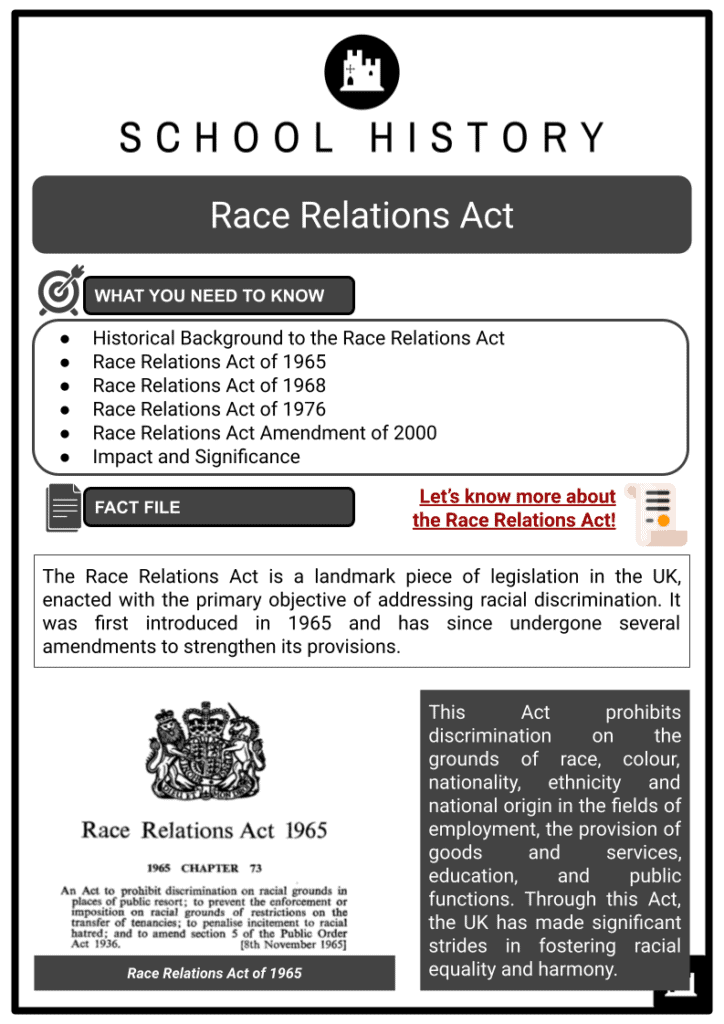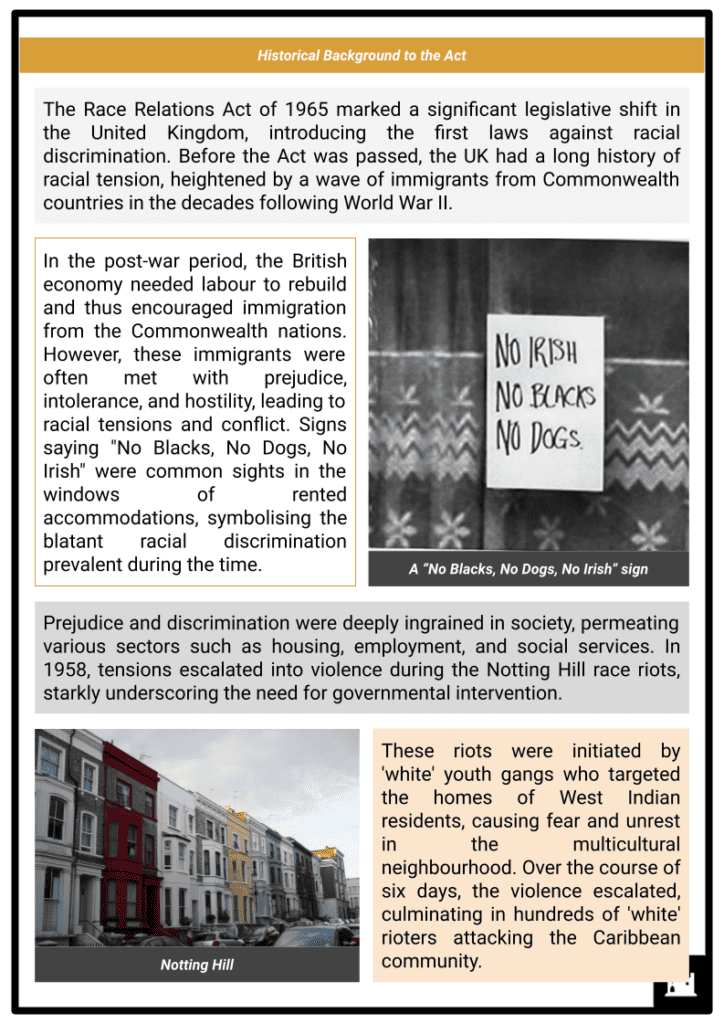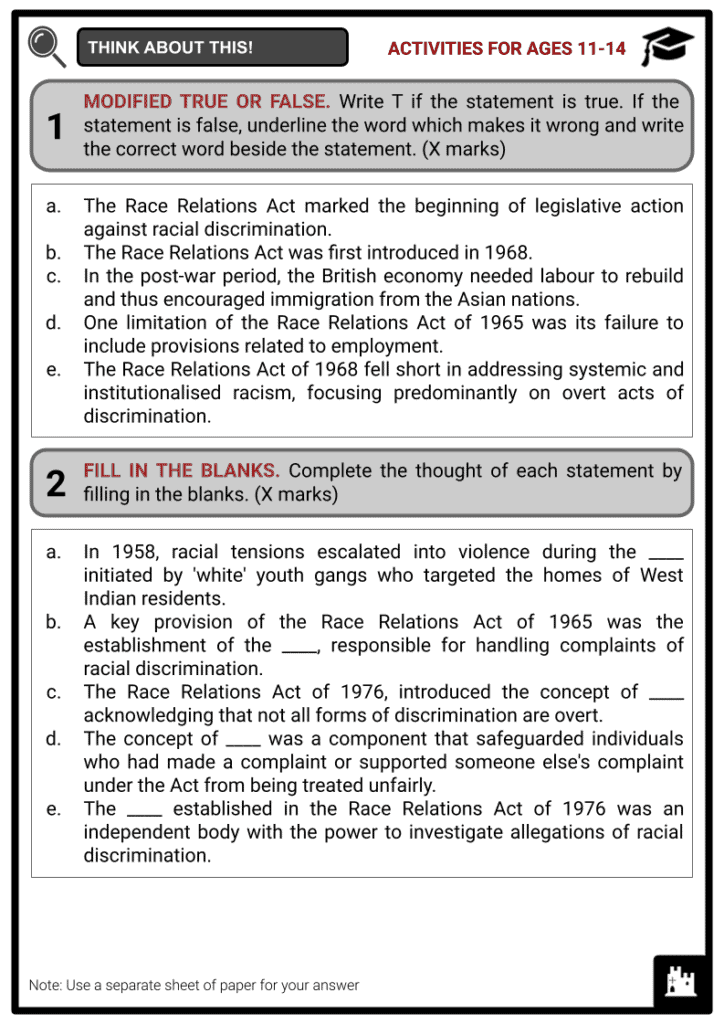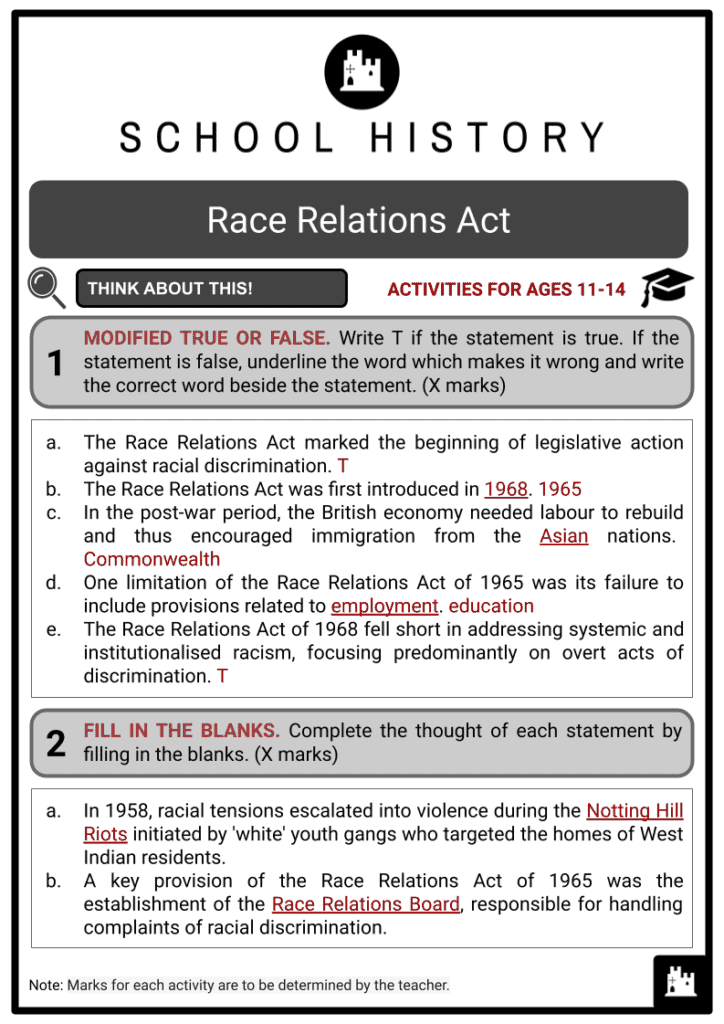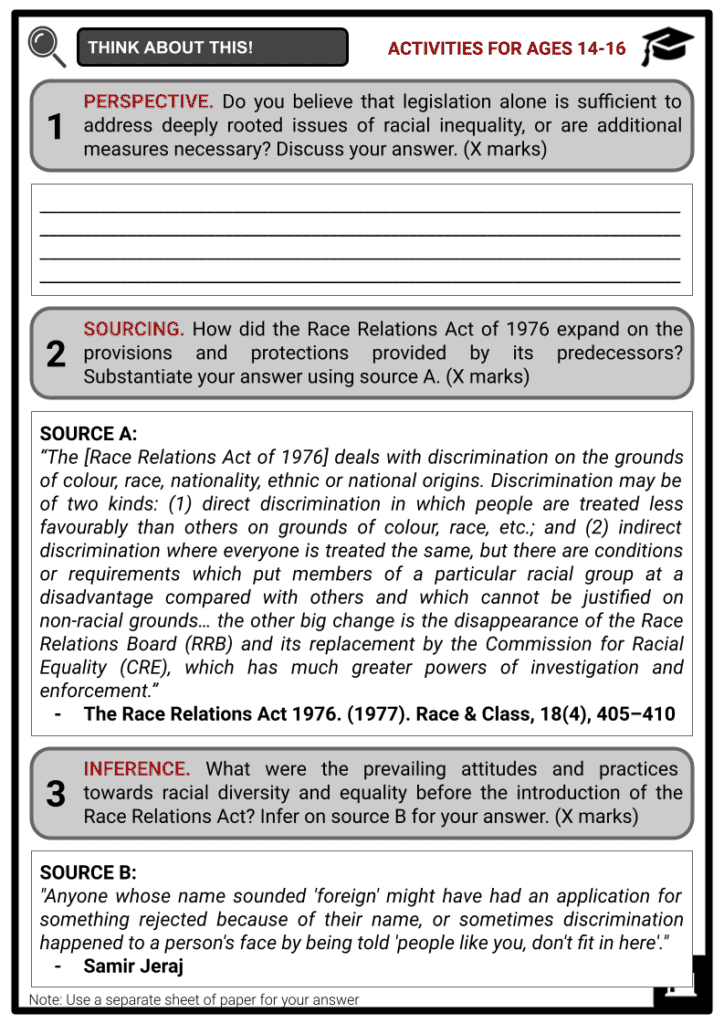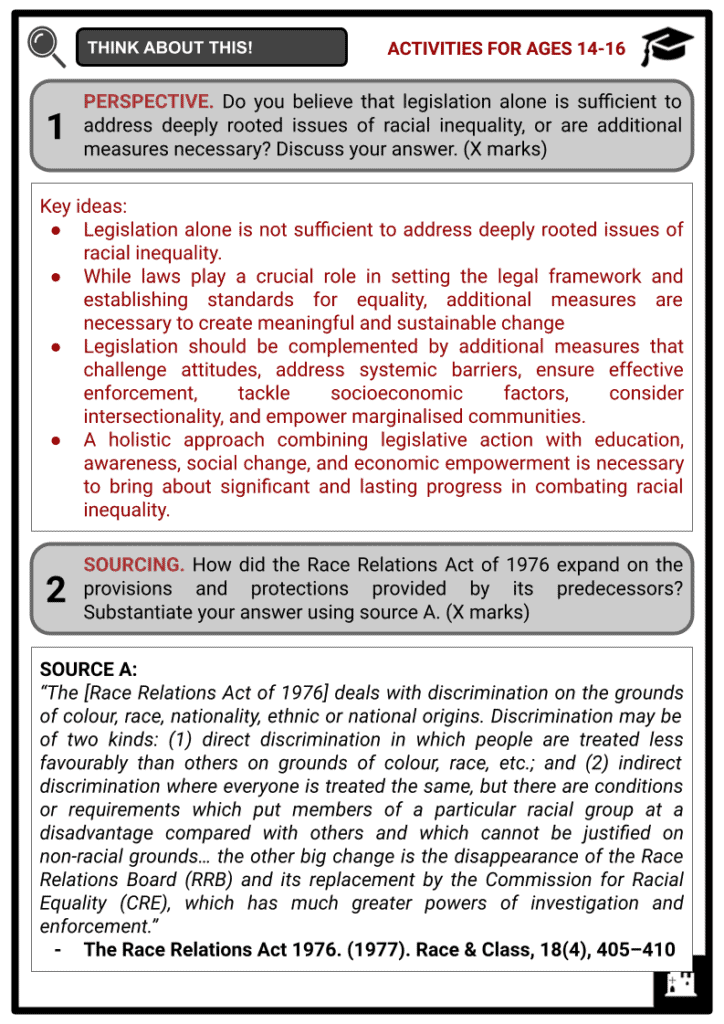Race Relations Act Worksheets
Do you want to save dozens of hours in time? Get your evenings and weekends back? Be able to teach about the Race Relations Act to your students?
Our worksheet bundle includes a fact file and printable worksheets and student activities. Perfect for both the classroom and homeschooling!
Summary
- Historical Background to the Race Relations Act
- Race Relations Act of 1965
- Race Relations Act of 1968
- Race Relations Act of 1976
- Race Relations Act Amendment of 2000
- Impact and Significance
Key Facts And Information
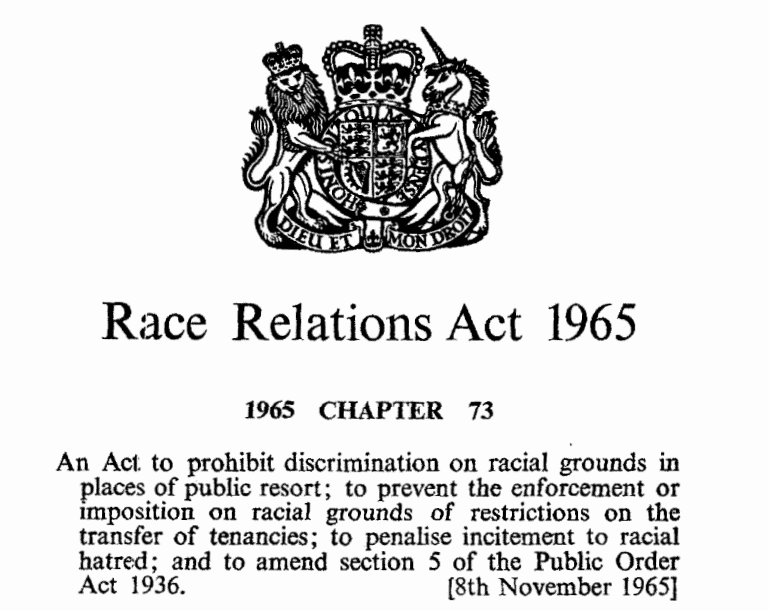
Let’s know more about the Race Relations Act!
The Race Relations Act is a landmark piece of legislation in the UK, enacted with the primary objective of addressing racial discrimination. It was first introduced in 1965 and has since undergone several amendments to strengthen its provisions. This Act prohibits discrimination on the grounds of race, colour, nationality, ethnicity and national origin in the fields of employment, the provision of goods and services, education, and public functions. Through this Act, the UK has made significant strides in fostering racial equality and harmony.
Historical Background to the Act
- The Race Relations Act of 1965 marked a significant legislative shift in the United Kingdom, introducing the first laws against racial discrimination. Before the Act was passed, the UK had a long history of racial tension, heightened by a wave of immigrants from Commonwealth countries in the decades following World War II.
- In the post-war period, the British economy needed labour to rebuild and thus encouraged immigration from the Commonwealth nations. However, these immigrants were often met with prejudice, intolerance, and hostility, leading to racial tensions and conflict. Signs saying "No Blacks, No Dogs, No Irish" were common sights in the windows of rented accommodations, symbolising the blatant racial discrimination prevalent during the time.
- Prejudice and discrimination were deeply ingrained in society, permeating various sectors such as housing, employment, and social services. In 1958, tensions escalated into violence during the Notting Hill race riots, starkly underscoring the need for governmental intervention.
- These riots were initiated by 'white' youth gangs who targeted the homes of West Indian residents, causing fear and unrest in the multicultural neighbourhood. Over the course of six days, the violence escalated, culminating in hundreds of 'white' rioters attacking the Caribbean community.
- The riots had a profound impact, bringing the issue of racial discrimination to the forefront of national consciousness and sparking widespread public debate. The severity of the riots, coupled with the extensive media coverage, made it impossible for the government to ignore the gravity of racial tensions in the UK.
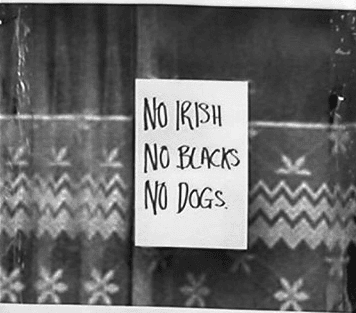
A “No Blacks, No Dogs, No Irish” sign - Public outcry and political pressure following the Notting Hill riots were instrumental in fast-tracking anti-discrimination legislation. In response to growing concerns, the government commissioned a study in 1965, led by Lord Brooke of Cumnor, to investigate racial discrimination. The findings of this study served as the groundwork for the Race Relations Act.
Race Relations Act of 1965
- The Race Relations Act of 1965 was a monumental step forward in the fight against racial discrimination in the United Kingdom. The Act made it illegal to refuse housing, employment, or public services to a person on the grounds of colour, race, ethnicity or national origin, marking the first legislative attempt to address racial discrimination.
- The Act was divided into distinct provisions, each designed to tackle different aspects of racial discrimination. First, the Act made it illegal to refuse or impose restrictions on the sale or rent of residential property based on race. It extended this non-discriminatory principle to the employment sector, making it unlawful to refuse employment or promotion or to dismiss someone because of their race.
- In addition, the Act prohibited racial prejudice in the provision of goods, facilities, and services. This meant that businesses and public services could not refuse or provide substandard services on the grounds of race, ethnicity, or national origin.
- Another key provision was the establishment of the Race Relations Board, responsible for handling complaints of racial discrimination. The Board had the authority to investigate complaints, with legal recourse to ensure enforcement if necessary. This was a significant milestone, providing an official body to oversee and enforce the Act’s provisions.
- Finally, the Act established a criminal offence for incitement to racial hatred, with those found guilty liable to a fine or imprisonment. This provision aimed to curb speech, publications, and public actions that could stir racial hatred.
- Despite the groundbreaking nature of the Race Relations Act, it was not without its limitations. The Act failed to cover indirect discrimination, where policies appearing neutral disproportionately affect certain racial groups. This loophole allowed covert forms of discrimination to persist. Furthermore, the Act did not initially apply to the police, enabling racial profiling and discriminatory stop-and-search practices to continue unchecked.
- The Race Relations Board, while a significant institutional development, was criticised for its perceived lack of power to enforce the Act. It could only handle individual complaints and was reliant on the goodwill of businesses and landlords to comply with its rulings.
- In addition, the Act did not include any provisions related to education, which meant that racial segregation and discrimination within schools were not legally addressed. Lastly, the criminal offence of incitement to racial hatred was difficult to prosecute, as it required proof of intent, allowing prejudiced speech to often go unpunished.

Lord Brooke of Cumnor
Race Relations Act of 1968
- Responding to the shortcomings of the initial Act, the Race Relations Act of 1968 extended the scope of the legislation, making it comprehensive. This Act not only covered housing, employment, and public services, but it also included provisions against discrimination in advertisements and education, essentially broadening the areas where discrimination was prohibited.
- The Race Relations Act of 1968 introduced several key provisions to rectify the limitations of its predecessor. Firstly, it expanded anti-discrimination protections to include both direct and indirect forms of discrimination. This meant that policies or practices that had a disproportionate impact on certain racial groups, even if not explicitly discriminatory, were now unlawful.
- Secondly, the Act extended its reach to cover areas previously exempt, such as education and advertising. This ensured that racial discrimination was prohibited in schools and the dissemination of advertisements.
- Thirdly, the Act strengthened the enforcement powers of the Race Relations Board, allowing it to conduct its own investigations rather than merely responding to individual complaints. Moreover, the Board could now issue legally binding instructions to those found guilty of racial discrimination.
- Finally, the Act made it easier to prosecute the criminal offence of incitement to racial hatred by lowering the burden of proof. Instead of requiring proof of intent, convictions could now be secured with evidence of the likelihood to stir racial hatred. These changes marked a significant step forward in the fight against racial discrimination in the UK.
- While the Race Relations Act of 1968 made progress, it did have its limitations. The Act fell short in addressing systemic and institutionalised racism, focusing predominantly on overt acts of discrimination. The lack of robust mechanisms for the recognition and redress of racial disparities in socioeconomic aspects, such as housing and employment opportunities, was a significant shortcoming.
- Furthermore, the Act's enforcement powers were still limited, with many cases of racial discrimination going unaddressed due to challenges in proving intent or likelihood of inciting racial hatred. These limitations highlighted the need for more comprehensive and effective legislation to address the multifaceted nature of racial discrimination.
Race Relations Act of 1976
- In 1976, the Race Relations Act was further amended and strengthened, extending its coverage beyond public bodies to private organisations and individuals. It prohibited discrimination on the grounds of race, colour, nationality, ethnicity and national origin in the fields of employment, the provision of goods and services, education, and public functions.
- The Act introduced the concept of 'indirect discrimination', acknowledging that not all forms of discrimination are overt. Indirect discrimination refers to practices, procedures or rules which apply to everyone, but disadvantage a particular racial group.
- Moreover, the concept of 'victimisation' was also recognised for the first time. This component safeguarded individuals who had made a complaint or supported someone else's complaint under the Act from being treated unfairly.
- The Act also established the Commission for Racial Equality (CRE), an independent body with the power to investigate allegations of racial discrimination, issue non-discrimination notices, and initiate judicial proceedings against violators. The CRE played a crucial role in highlighting systemic issues and advocating for change, making the 1976 Act a major milestone in the history of anti-racist legislation in the UK.
- Although the Act marked a notable milestone in the fight against racial discrimination, it is important to acknowledge its inherent limitations. The Act did not sufficiently address indirect racial discrimination, where policies appearing neutral disproportionally affect certain racial or ethnic groups.
- Furthermore, it lacked the reinforcement of tangible consequences for non-compliance, resulting in many organisations continuing discriminatory practices. The Act also did not encompass systemic racial disparities present in key areas such as education and housing. Lastly, it placed the burden of proof on victims, making it challenging for individuals who faced discrimination to seek justice.
Race Relations Act Amendment of 2000
- Building on the foundational principles of the Race Relations Act of 1976, the Race Relations Act Amendment of 2000 introduces several vital provisions to strengthen the protections against racial bias.
- One of the key provisions of the Amendment is the expansion of the original Act's scope to include public bodies. This development means that institutions such as the police, local councils, and schools, previously exempt, are now held to account for their policies and practices, ensuring they do not foster or perpetuate racial discrimination.
- Another notable aspect is the introduction of the positive duty to promote racial equality. Rather than merely prohibiting racially discriminatory practices, the Act now requires public bodies to proactively encourage racial equality. This progressive move sets a higher standard, compelling these institutions to identify and eradicate racial disparities in their operations.
- The Act also mandates the creation and implementation of Race Equality Schemes by public bodies. These are strategic plans that outline how each body intends to fulfil its duties under the Act. Regular monitoring and revision of these schemes ensure that they remain relevant and effective.
- Moreover, the Act reinforces the powers of the Commission for Racial Equality, enabling it to enforce the new legislation. It can now carry out investigations and require public authorities to take specific actions to address identified issues.
- The Race Relations Act, along with its subsequent amendments, constituted a significant advancement in civil rights in the UK. It laid the foundation for the racial equality we strive for today, reinforcing the principle that all individuals, regardless of their race or ethnic background, deserve equal treatment. These key provisions have shaped the legal landscape, making it clear that racial discrimination is unacceptable and will be met with severe legal consequences.
Impact and Significance
- The Race Relations Act has had far-reaching impacts and a profound significance in UK society. It marked the beginning of legislative action against racial discrimination, a move that sent a clear message about the country's commitment to equality and justice.
- Firstly, the Act has served as a deterrent against racial discrimination in various facets of life. It established that such behaviour is not only morally unacceptable but also legally punishable, thus promoting a more equitable society. Institutions and businesses became more cautious in their practices, striving to maintain a racially unbiased environment.
- Secondly, the Act has played a vital role in changing societal attitudes towards race. By emphasising the importance of racial equality in law, the Act has contributed to a broader cultural shift in perceptions and attitudes towards race. It has encouraged a more inclusive society where diversity is respected and celebrated.
- Finally, the Race Relations Act has set the precedent for future legislation on racial equality. It paved the way for additional amendments and acts that have further bolstered the fight against racial discrimination. These pieces of legislation have built upon the foundation laid by the Race Relations Act, continually refining and expanding protections against racial discrimination.
- The Race Relations Act has had a transformative impact on UK society. Its legacy goes beyond the legal realm, influencing societal attitudes and fostering a culture of inclusivity and equality. The Act's significance cannot be overstated as it continues to shape the approach to race relations in the UK, reminding us of the ongoing struggle for racial equality and the importance of legislative action in this pursuit.
Frequently Asked Questions
- What is the Race Relations Act?
The Race Relations Act is a series of laws that address racial discrimination and promote equal opportunities for all, regardless of race or ethnicity. The act makes it illegal to discriminate based on race, colour, nationality, ethnicity, or national origin in various areas of public life.
- What are the key provisions of the Race Relations Act?
The act prohibits racial discrimination in areas such as employment, education, housing, and providing goods, facilities, and services. It also established the Commission for Racial Equality (later replaced by the Equality and Human Rights Commission) to enforce the legislation and promote equal opportunities.
- Is the Race Relations Act still in effect today?
The original Race Relations Act has been repealed and replaced by the Equality Act 2010 in the UK. The Equality Act 2010 consolidates and strengthens various anti-discrimination laws, including race-related ones, into a single piece of legislation. So, while the specific Race Relations Act from 1965 is no longer in effect, its principles are encompassed within the Equality Act 2010.

